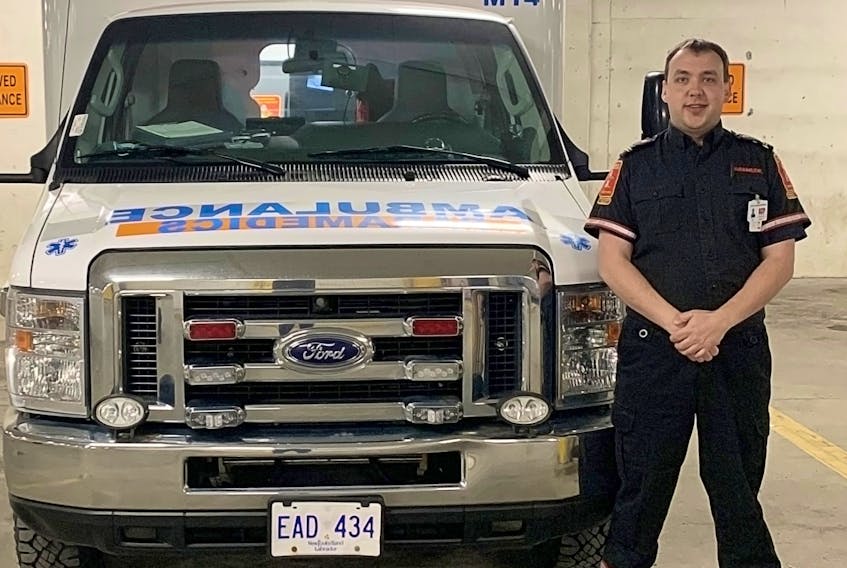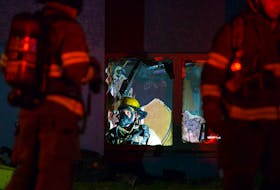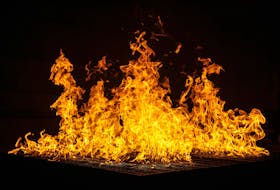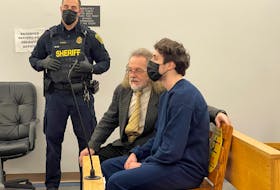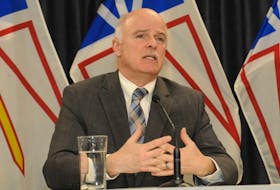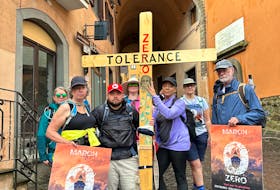ST. JOHN'S — The early weeks of the COVID-19 pandemic were a time of uncertainty for metro St. John’s advanced care paramedic Mark Jenkins, as they were for many other first responders.
“First when the lockdowns started happening, initially (there was) the sense of just anxiety, a little bit of fear. It was something new. It was unknown. The fact of working in health care and working so closely with people that may have had COVID-19 and the thought of bringing it back to my family caused a lot of anxiety,” said Jenkins, who has a son who is almost eight.
As a precaution, he would enter his home through the basement and shower there before greeting his family. Uniforms are taken home in a bag for washing or drycleaning. Other co-workers sent their children to stay with grandparents, he said.
Related
- Faces of the frontline: Dr. Steve Major screens for COVID-19 at St. Teresa’s
- Faces of the frontline: 'I feel really proud to be from Newfoundland and get to work as a nurse,' says Kaitlin Lundrigan
It was also a different scene out on the streets — no rush-hour traffic, retail stores closed and hardly any vehicles meant less calamity.
“Paramedics are usually busy during rush hours,” Jenkins said.
“Waiting rooms in hospitals were deserted. It was an eerie feeling.”
There was also uncertainty in the health care system generally in Canada and around the world, with workers not knowing what to expect based on places that had seen COVID-19 overwhelm their hospitals, and access to personal protective equipment (PPE) — due to a worldwide shortage — was uncertain.
Jenkins said the paramedics always got the PPE they needed to do their job safely, however.

Health Minister Dr. John Haggie, in the COVID-19 briefing Monday, said the province is keeping up with the demand for PPE across all the regional health authorities and various health-care personnel, although most gown sizes are only ahead by a week’s supply, while various other PPE is four weeks ahead.
Haggie told reporters during the virtual briefing there is a tremendous amount of work done in the background to keep the supply rolling. (Face shields are being sourced from Newfoundland and Labrador company PolyUnity, so they are not a problem.)
“It has been a struggle every week,” Haggie said of the PPE situation.
In the last few weeks, traffic has ramped up again as the province shifts from one level of precaution to another, and more businesses and services reopen.
And as time has gone on, with long stretches of no new cases of COVID-19, the anxiety level has dropped.
“The province has done a good job — the public health measures and the people of the province have done such a great job adhering to the measures,” Jenkins said.
Initially, a big issue was getting callers to 911 to be up front about whether they had symptoms, or had travelled.
Public health officials had stressed the necessity of supplying that information.
“We were still finding in the early stages, some people weren’t being forthcoming with that info,” Jenkins said.
“I don't know if they thought it would make a difference in us responding. It never makes a difference — it was more so for us to provide the best care.”
“The province has done a good job." — Mark Jenkins
Working when many businesses were closed meant paramedics brought more meals and snacks from home for their breaks. Gas stations remained accessible for bathroom breaks, or they would return to their satellite stations.
Some patients were a bit unsettled by the gowns and surgical masks, which were not what they would normally see.
“We just tried to explain to people early on the reasons why we were wearing this stuff, not only to protect ourselves from bringing anything home to our family, but to protect the patients, since we were in so many different homes dealing with so many different people,” Jenkins said.
It took a few extra seconds to put on the PPE, and for some families that seemed like hours.
Call volumes in the early weeks dropped, Jenkins said, because people were reluctant to go to the hospital.

Fears of contracting COVID-19 were part of that reluctance, but with the strict procedures, the chances of patients contracting the coronavirus that way were next to nil, Jenkins said.
As well, with the drop of traffic, there weren’t nearly as many accidents.
A 12-hour shift that saw seven to nine calls in normal times dropped to three or four calls in the early weeks of the crisis.
“And chances are, these people were very sick. They had no other avenue to turn to,” Jenkins said.
But within the last couple of weeks, the call volume is back up.
Haggie said during Monday’s briefing that while he doesn’t know the emergency call numbers by regional health authorities to speculate on any trend in volumes, the overall work of ambulance operators in the province was down due to not having routine transfers from one facility to another.
Posted by Mark Jenkins on Sunday, August 26, 2018
Jenkins said he and his wife have always tried to encourage their son to ask questions, and he’s accustomed to his dad’s work.
He is also savvy, Jenkins said.
"He is probably, for an eight-year-old, one of the most well informed to advise of public health measures. … He tells his grandparents what they need to know, how many people are in their bubble,” Jenkins said.
While the ability to get together with coworkers in a social setting to decompress is suspended, the support never missed a beat, Jenkins said.
“We’re such a close-knit team, we are always looking out for one another, whether a simple phone call or text. … Seeing if they need anything. It’s a great team,” he said.
As for a potential second wave of COVID-19, Jenkins said it’s on everyone’s mind, but there are good measures in place, even if that means tightening restrictions for a time again.
“Newfoundland and Labrador will have no problem curbing the second wave,” Jenkins said.
Twitter: @BarbSweetTweets

